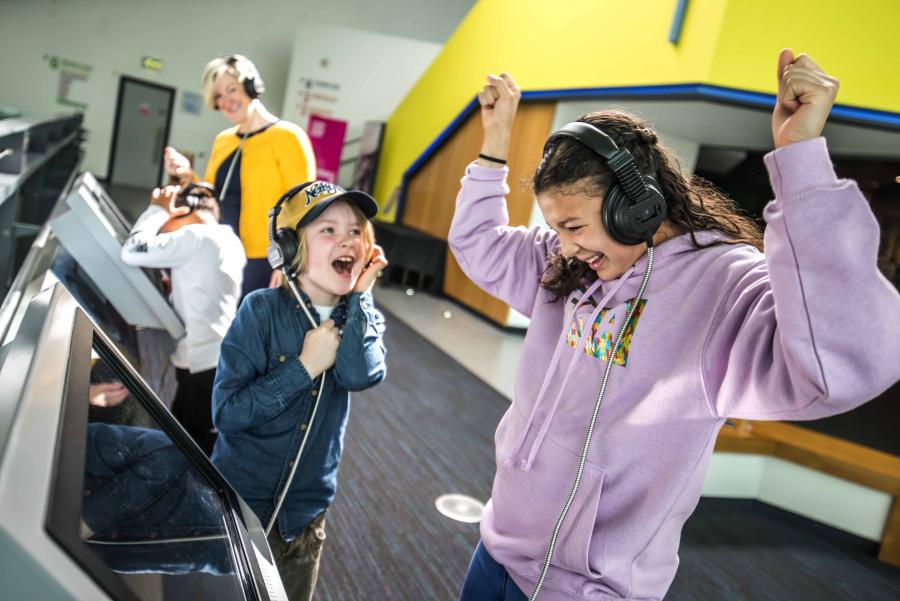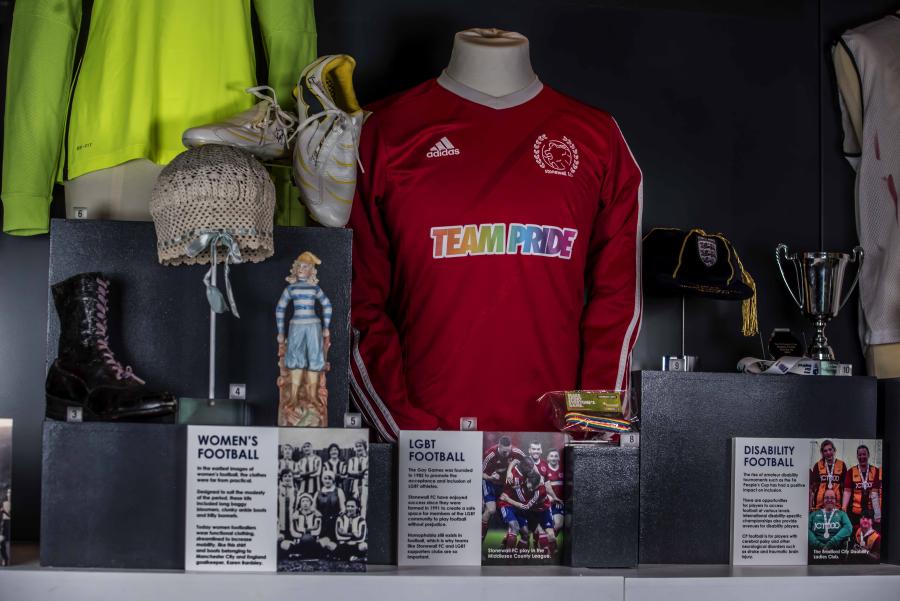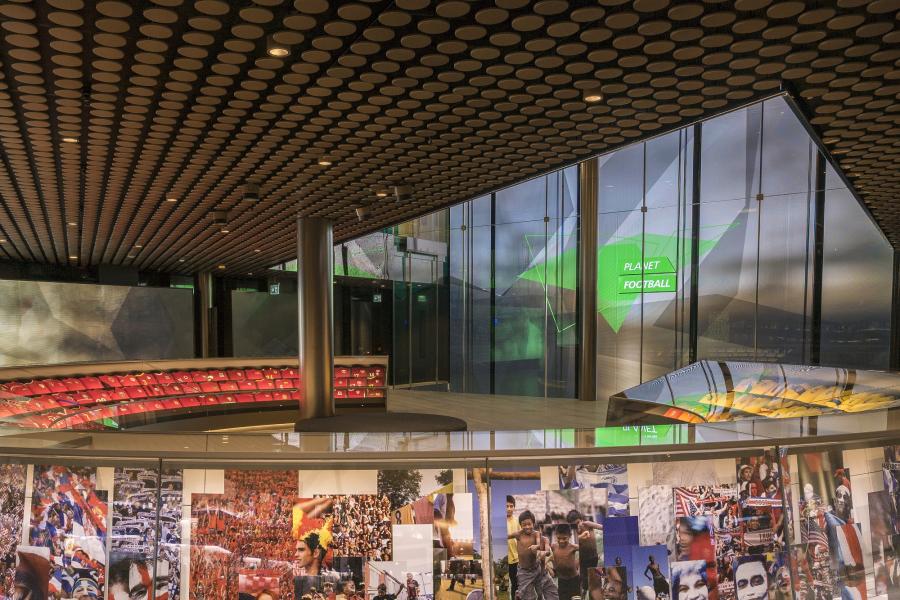At the National Football Museum in Manchester, England, you’ll find the “Crossing the Line” exhibition on women’s football, children swapping football stickers, Geoff Hurst’s bronzed boot from England’s 1966 World Cup win, and Sporting Memories programs for older people.
By embracing the diverse stories of the “game of our lives,” England’s National Football Museum reaches audiences old and new. CEO Tim Desmond wants the museum to reflect and support social change, promising participation and involvement for all. His goal is “a resilient, award-winning museum with education at its core, which represents the football family in all its diversity.”
He began by putting the museum on a surer financial footing. Although popular with visitors, it had faced funding challenges since opening in 2001. It spent its first decade in Preston, Lancashire, England, before its funding ended. Manchester City Council then stepped in, bringing the museum to Manchester’s Urbis building in 2012. Historically, the National Football Museum has been free to enter. However, it receives no core funding from the Department for Digital, Culture, Media & Sport nor football bodies. To address the need for funding, it introduced an admission charge for all non-Manchester residents in January 2019.
“It’s put a real value on the visit. Also, 25-40% of our visitors are international, and they don’t think twice about paying,” Desmond says. “Moving towards a charging model saved us. It brought income into the organization that wasn’t there before, and we built up our reserves ahead of the pandemic. We were supported by the [government’s] Culture Recovery Fund to protect some of those reserves, so we could sustain and develop ourselves when we reopened.”
Promoting Diversity and Equality
November 2022 brought the welcome news that Arts Council England had awarded the museum National Portfolio Organisation status for its “Football Creates” initiative. “Football Creates” creatively engages people and communities, fosters inclusion, and improves well-being through special exhibitions, workshops, and events (including hosting toddler activity sessions, dance groups, and dementia choirs). The museum will receive £1 million in funding over three years.
“We’re championing diversity and equality in football,” Desmond says. “Three years ago, we decided to rebalance our collection and programs to be 50% represented around women in football; 100% of our exhibitions during the Women's Euro 2022 [championship] were around women in football, and that’s been really positive. In the Hall of Fame, 50% of inductees are represented through the women’s game. It’s not been difficult to do, and our female visitors have risen.”
Recent debates in football have focused on whether personal beliefs or statements have a place within the game.
Team captains from England, Wales, Belgium, the Netherlands, Switzerland, Germany, and Denmark planned on wearing the OneLove armband during the World Cup, which features a rainbow heart to signal solidarity with the LGBTQ+ community. However, FIFA threatened to issue yellow cards to any player wearing one, dictating that team equipment must not have any political, religious or personal slogans, statements, or images.
The National Football Museum wants to accelerate progress towards a more inclusive culture to bolster enjoyment of the sport across all demographics.
“We celebrate England’s Para teams. Although [England captain] Harry Kane isn’t playing in Qatar with the OneLove armband, we display one. We’re not funded by football, so we can be more creative, cultural, and independent in terms of how we deliver exhibitions.”
The museum has two World Cup-inspired exhibitions. “No Score Draws” tells the World Cup story through football sticker art; guests can add their own doodles. Another mini exhibition, “Cards of Qatar,” reveals the stories of migrant workers in Qatar.
Its Football Writing Festival brings together sports writers and journalists. “We do YouTube Shorts and podcasts around the tournaments,” says Desmond. Art workshops, sticker swaps, and gallery trails galvanize interest. “We’ve got an exhibition celebrating the Premier League’s 30th anniversary next year,” he adds.
He plans to transform the museum’s galleries in the coming years, making them fit for future audiences (increasing digital play, for example). Exhibition infrastructure must be flexible, accessible, and environmentally sustainable.
“We need to diversify our organizations even more. We’re looking at rebalancing our team. Diversity is so important to reach our audiences.” The museum works with more freelance artists to ensure exhibitions are different and include multiple viewpoints. “We must listen to our communities and visitors,” Desmond says.
The Power of Partnerships
The museum has built relationships with cultural leaders at home and abroad. It recently loaned England and Liverpool ace Trent Alexander-Arnold’s “Black Lives Matter” boots to the FIFA Museum in Zurich, Switzerland, as part of its “211 Cultures. One Game” exhibition, launched ahead of the World Cup.
The Zurich exhibition celebrates football’s history, heritage, and culture, showing how it connects and inspires people worldwide. “We have always wanted to work closely with FIFA’s 211 member associations and fans from around the world,” says FIFA Museum managing director Marco Fazzone. The exhibition contains objects and stories from all 211 FIFA member associations. “We thought it was the perfect moment to reflect on how the beautiful game is played and enjoyed across the globe,” Fazzone says. The museum is also screening all 64 World Cup matches, creating "a great atmosphere."
When Fazzone took over in 2018, the FIFA Museum (not publicly subsidized) faced organizational and financial challenges that required a new content vision. Investing in the team was “the best decision” he made. “We started by asking ourselves: ‘What does our museum stand for? What is our profile?’ Then we began restructuring—thinking not only locally, but also internationally, digitally, and institutionally.”
FIFA Museum’s “biggest asset is to bring fans from around the world closer to legends and to trigger emotions and memories based on objects and storytelling,” Fazzone says. “We have a permanent exhibition with one of the finest collections of original objects from the football world. We have also started developing rotating special exhibitions like ‘211 Cultures. One Game.’”
For the 2022 FIFA World Cup in Qatar, it teamed up with Hyundai to present “Goals Create History,” a free exhibition at the FIFA Fan Festival in Doha. It features artifacts and stories from each of the FIFA World Cup finals since 1930, as well as multimedia experiences and FIFA Museum’s iconic “Rainbow of Shirts,” with the jerseys of all 32 teams participating in this year´s tournament. “We can meet fans on the ground at our temporary exhibitions and collect football history as it is made,” Fazzone says.
Exploring Wider Opportunities
The Doha project is a testament to the FIFA Museum’s outward-looking strategy. “We are highly attractive in the international market,” Fazzone says. In addition to Doha, “we have had very successful special exhibitions in Moscow during the FIFA World Cup Russia 2018 and Paris during the FIFA Women’s World Cup France 2019.” The museum has built new relationships across the sports and cultural sector, for example through its international annual football museums conference and collaboration with the Zurich Film Festival.” There’s an active education and cultural program. “We have unique monthly events where fans can listen to experiences, stories, and anecdotes from legendary players and coaches.”
The museum’s ambassador program includes luminaries such as Uruguay’s Diego Forlán, Italy’s Gianluca Zambrotta, Swiss star Prisca Steinegger, and Swiss goalkeeper Pascal Zuberbühler. The museum also regularly hosts events. “We have a big cultural heart beating in our chest, but we must always consider the commercial aspects,” Fazzone says.
“Next year, we look forward to opening special exhibitions about Italy’s football legend Paolo Rossi and the history of women’s football while the FIFA Women’s World Cup 2023 takes place in Australia and New Zealand.”
The museum learned from its pivot to digital programming during the pandemic. “We have been able to share our additional digital content with up to four million fans worldwide per year,” Fazzone says. It produced new digital exhibition formats like “The Origins of Football” and plans to release new virtual and augmented reality activations.
Fazzone wants to balance digital offerings and real-life interactions between guests, artifacts, and sporting legends. “We are as passionate as the fans. We love to share the magic of football. When it comes to the quality of our exhibitions, objects, and stories, we do not want to make any compromises.” He hopes to work on more collaborative exhibition projects and “find new ways of showcasing the cultural impact of football and its influence on design, fashion, music, art, and more, to bring football heritage to wider audiences.”
Football has become a global cultural phenomenon. Likewise, football museums that are financially self-sustaining and at the top of their game can unite people from all walks of life.





